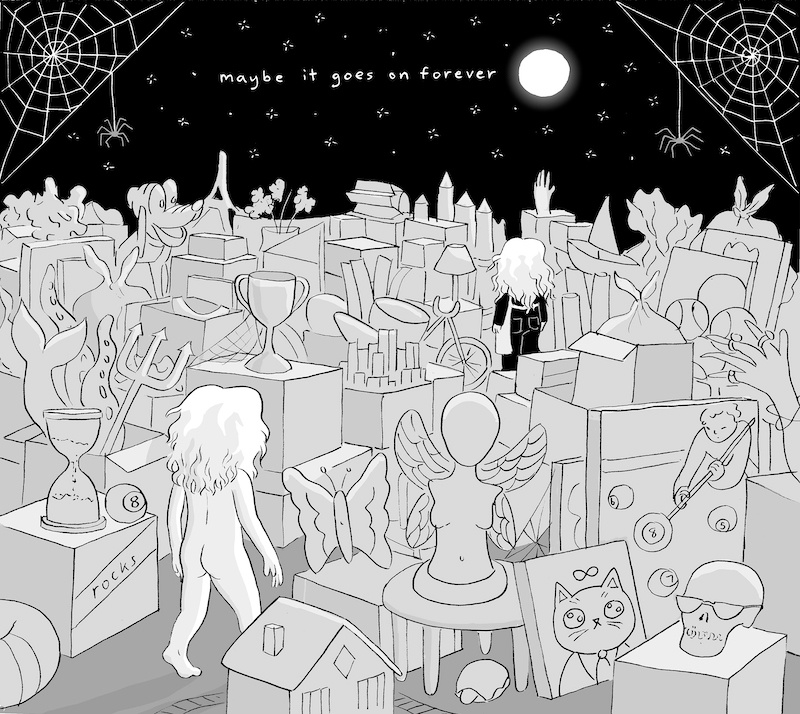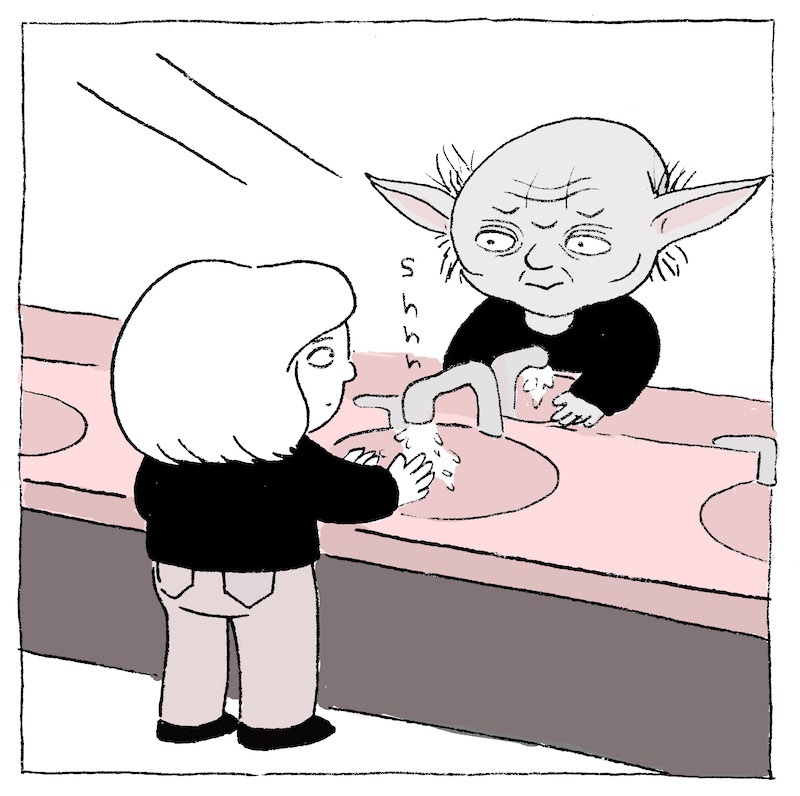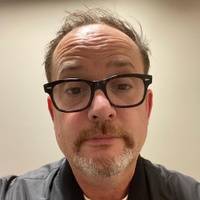On sustaining your practice
Prelude
Daryl Seitchik is a cartoonist and teacher. She is the author of the Eisner-nominated graphic novel Exits (Koyama Press, 2016) and the ongoing semi-autobiographical comics series Missy, which was recently published in The New Yorker. Her most recent book, Now and Other Dreams (Fieldmouse Press, 2022) collects surreal short story comics made over the last ten years. Daryl teaches comics workshops at schools, libraries, and museums throughout New England. She has two adorable cats and co-runs the micropress Parsifal Press with her partner in Vermont.
Conversation
On sustaining your practice
Cartoonist Daryl Seitchik discusses channeling memories into art, not becoming jaded, and living a balanced artistic life.
As told to Ariel Courage, 2836 words.
Tags: Comics, Art, Education, Process, Beginnings, Mentorship, Time management, Day jobs, Money.
When did your interest in art begin?
When I was little, people always gave me blank books as gifts. I’d fill them up with illustrated stories as soon as I learned how to write. Sometimes I’d have people write sentences for me if I didn’t know how to spell things.
I’d also write down stories in elementary school and then tape the tops of pages to the bottoms of other pages and make this long scroll. When we’d have to read them in front of the class, everyone else would have one or two pages to read, and then I’d come in with my scroll and everyone would groan and it would be like 11 pages and I’d read the whole thing. I was encouraged by my family, so I didn’t think there was anything wrong with torturing people with my scroll stories.
It sounds like you were always combining words with visuals. Was there a particular moment when you decided to pursue comics?
I read comics as a kid, like Archie, but didn’t put it together that I could make comics until college. I was an English major, so I thought I’d be a writer, even though I was always doing art. Eventually, academics felt too dry, and I missed visual art, so I took a figure drawing class at RISD the summer before my junior year, and the professor encouraged me to switch majors to art. I found all these comics in the library, including ones by Julie Doucet and Gabrielle Bell. It was like a light switched on. Reading them made me realize I could do it, because they were telling stories about their own experiences, which I hadn’t seen before in comics—I’d read Blankets, and it was impressive, but I couldn’t relate to the story, and I didn’t read it and think, “I can do that.”
So, I went back to college, switched majors, pitched a weekly strip to the university paper—even though I’d never drawn a comic before—and they accepted it. I also drew diary comics I never showed anyone. I met a friend through the newspaper, Stephanie Mannheim, who knew way more about the indie comics scene than I did. She knew about Desert Island and SPX. We started going to shows together. That’s been my life ever since. I also want to give a shout-out to Karen Green, the comics librarian at Columbia University—the comics collection there was essential to me.
The summer before my senior year, I blindly emailed Gabrielle Bell to ask if I could be her intern, and she said yes. I’d go to her apartment and help color The Voyeurs, though I had no Photoshop skills. That gave me a window into what it was like to be an adult making comics in the real world.

What did you learn about being an adult making comics?
I don’t know what I expected going in, but I realized it wasn’t a sparkly, fancy career choice. She was just drawing out of her bedroom, but she had such a cool life. She was living in Greenpoint and had all these cool friends. Everything she did centered around her craft, and I wanted that, too, even if it wasn’t as materially rewarding as other choices. Seeing her do that was inspiring.
What is your process of mining from your own experiences—your past, childhood, and subconscious?
Lately I’ve been doing more comics about fresh material—straight from experience to ink—and that’s been fun. More often what I do requires a bit of fermentation.
Almost everything starts in my diary. Especially for Missy, I had to wait years to have distance from the experience so that I could refine the raw material. Also, the distance of time helps the memory become big enough that my subconscious can get in there and do something weird. It’s helpful to not remember things exactly. However I’m feeling right now about it can come in. The way my subconscious experiences an event is often more interesting to me than what actually happened.
Emotional truths about awe or grief or rage often emerge in these comics, and subconscious symbolism takes precedence over facts. In extreme cases, I have to resort to accidental poem-comics, like in Now and Other Dreams, instead of saying what is actually happening.
Is there a way you can tell as you’re working on a comic that it’s becoming too literal?
If it’s very literal, I get too bored or frustrated to finish. I’ll realize it’s because I’m not letting my subconscious work. I’m not letting myself have fun or tell the truth. If it’s starting to burn me out while I’m working on it, that means I’m hiding something from myself.
My friend Cathy Mayer came up with this concept called TAIDMU, or Text and Images Don’t Match Up. If the text and the images are redundant—if there’s no tension between them—that leads to a lack of dimensionality. Sometimes narrative flatness helps create a desirable deadpan tone, but I like exploring that tension, and it helps me break out of being literal.
How aware of that are you when making a comic?
It comes naturally. When I’m working on Missy, I often choose diary entries that feel like they have visual potential, even though I don’t know what the visuals will be. Once I write the sentences, the images come to me.
Once I start drawing the comic, I realize what the tension is between the drawing and the words. Obviously, when I was eight years old and writing about feeling lonely in the third grade, I didn’t include a drawing of Yoda; it’s just what felt right when I was working on the comic years later. It’s about letting the feelings spill out into the drawings. What can’t be said—what I don’t want to put in words—comes through. That’s where the tension comes from.
I love beginning with words. Having a good first line is usually enough to start. I also find it grounding to use a first-person narrative, with a story taking place in one person’s body. Once I have basic sentences or ideas, I pick a grid. I love the six-panel grid, it’s like a pop song.
I’ll map words onto my grid and split sentences up based on my desired pacing. Sometimes a sentence’s cadence determines how many panels happen between one sentence and another, and that rhythm determines how much space I give a particular scene. I think about where a panel will appear in the book, like on a spread or a page turn. I’ll do loose thumbnails sometimes, though all the stories in Now and Other Dreams went straight to finished pencils because it was pure subconscious.

Your work feels cohesive, but you use various styles. How do you decide which style is most apt for the story you’re telling?
The only thing that’s consistent is that I give every cartoon character the same face. Otherwise, every project I do is a reaction to what came before. I started working on Follow the Doll right after I finished Exits, and they’re completely opposite comics. I drew Exits in six months, and it’s minimal. The main character isn’t drawn for most of it because she’s invisible, and it’s in black and white. I had to ink a lot of it digitally to meet the deadline. You can see the pencils through some of the inks. That was an aesthetic choice.
By contrast, Follow the Doll—which entails lightboxing pencils onto watercolor paper and then painting the full page—is extremely time-consuming. I’m five years into it and not even halfway done. I call it my vertical time project. Some projects have deadlines, but this one I’m doing for my future old hag self.
Once you’ve committed you have to see it through. Besides college, do you have any other formal training that has enhanced your artistic process, helped connect you to a community, or otherwise aided you along your path?
I’m lucky because my family has always been supportive of my art. I had art lessons throughout childhood.
I went to The Center for Cartoon Studies (CCS) for my master’s back in 2018, and I still live near there with my partner [Dan Nott, who’s also a cartoonist] and am part of the community there. Before I went to CCS, my training in comics was just going to shows. That felt like its own type of school, where I met a lot of the cartoonists that I’m still friends with and consider peers.
It felt weird to come to CCS after being in the comics scene for six or seven years. I felt both cocky and insecure about being a student again, but I wanted to learn how to teach comics. I got a year for free, so I figured I’d take this opportunity to see how people teach comics, because I didn’t want to work in coffee shops for the rest of my life. It’s nice to have this built-in comics community and not only shows or the internet.
How has teaching been?
Before the pandemic, I worked at an after school program. Then I got laid off, so I eventually began teaching comics online and it became one of the things I now do for a living, virtually and in-person.
It’s pretty fun, though I made a comic about it called Class from Hell. I mostly teach kids at after school programs and visiting schools and libraries. I love spending time with them, maybe because I’m immature. I’m endlessly entertained by what they make. They’re not afraid of telling the truth. Sometimes I straight-up steal their ideas.
Maybe that’s my whole career: stealing ideas from my child self and the children I work with.
[laughs] Your work about childhood and your access to your child-self I’m sure is helpful for hanging out with kids. Do you feel like you maintain a good work-life balance?
I’m not great at managing my time, so I’m always working on that, but I feel I have enough time to be creative. The ways I make money—illustration, teaching—are only tangentially related to comics, but inspire me indirectly.
Working with the MFA students at CCS helps me monitor my own attitude toward comics and model a good attitude. I’m more responsible in my own relationship with comics because I know so many people who are excited about the medium. I’m also teaching an adult Intro to Drawing class at a community arts center. I haven’t had to think about drawing realistically since high school, but I’ve enjoyed getting back into that.
It’s easy to get jaded about art-making, but it’s inspiring to be around beginners, whether they’re learning how to draw a face or risographing their first mini-comic. Working with people in that beginner’s mindset helps me get back to that state.
What makes you feel jaded about comics?
The emphasis on productivity in the comics scene gets to me. The emphasis on having books out, on awards.
Even when I got those things, I didn’t feel good after. I used to think, “If I just get nominated for an Eisner, that’s it, I can rest on my laurels.” But when Exits actually got nominated, I got into this bad depression. The culture still insists you should want this external validation. Ten years in, it’s like, “If it makes me feel bad, what’s the point?” Then you sit down and draw and you’re like, “Oh, that’s the point.”
It’s also partly imposter syndrome, which can contribute to a sense of jadedness. It helps to remember that none of that stuff matters spiritually. It matters for your resume and for your clout, but not your soul.
That experience sounds hard, but maybe on the other side of that, there’s a good realization about why you’re doing this that helps you tune out all the noise.
Recently I’ve gotten a better grip on it, but even just a couple months ago, I was having a lot of trouble. It’s especially hard being surrounded by cartoonists with books coming out all the time. It’s so easy to be like, “Well, why haven’t I had a book come out in however long?”

It’s hard to resist the temptation to compare yourself to others and get down on yourself. Is there anything you’ve found helpful for pushing past that?
I recommend getting into a different practice entirely—not quitting your main thing, but having another one, another passion that isn’t the thing you’ve started to make toxic for yourself.
I started learning guitar at the beginning of the pandemic after I got laid off because I had all this time. I even started writing and recording songs. The excitement I felt at the beginning of making comics, when I was first writing, is now how I feel about making music, except I have no career ambitions about it, which is fantastic. I just want to finish songs and share them.
Now, because I’ve felt so immersed in these other creative projects, I feel refreshed about my attitude toward comics, because I know my worth isn’t tied to what I make. I’m just me and I enjoy making things. That’s what you have to remember. Otherwise you’re like No-Face in Spirited Away, trying to get everyone to take your gold so they’ll love you.
That’s upsettingly accurate. You mentioned trying to improve your time management. Are there any tricks you recommend so far?
Honestly, it’s not my strong suit. I have a fancy planner where I write down my to-do lists every day. I also have certain daily rituals or habits that help me function.
I always wake up and meditate for 20 minutes. Usually, it’s not a great meditation, but if I don’t do it, I’ll be an asshole. Then I have my coffee and write emails—all the uninspiring administrative work of freelancing. I teach mostly after school hours. I’m a night owl. I used to feel ashamed about not waking up early, because the whole capitalist world wakes up early, and so I felt out of rhythm with the world. Now I don’t care. It’s part of what keeps me feeling happy and healthy, and besides I’m more creative at night.
After dinner, I spend the night making something. Recently, I’ve been marking studio time with tea lights. When I start work, I light one candle, which has a 4-hour burn time. I won’t leave my desk while a candle is burning. I try to go through a candle a night; creating a magical environment helps me stay motivated.
Working in a standing position keeps me energized. Lastly, I hate being the person to advocate for this, but exercise is important to get energy out and be able to focus later.
Do you have any advice for people trying to establish their practice?
It’s important to prioritize your practice even if it’s not making you any money. It’s so easy to let the mundane aspects of life get in the way of what’s most important to you, or to put off something that seems to have no immediate material benefit, but if you want it to become a regular practice or career, you have to find the time of day that works for you to create and guard that space.
At the same time, don’t make art the center of everything; live a balanced life. When I started, I only cared about making comics, because I was excited and ambitious. I was career-focused, always trying to get to the next project, and it left no space in my heart for being with people and living my life. It wasn’t until after I got through the milestone of my first book that I realized there’s more to life than making art. Books are just one slice of the pie. You have to figure out what your pie is and try to equally distribute the slices. For me, it’s my friends, my partner, my cats, gardening, family, music, teaching. All of these are important for being a whole person.
There are ways to be creative in all aspects of your life. It’s useful for personal and artistic growth to see being a good artist and being a good person as interconnected. Your art practice is like a raised garden bed. It’s on the ground, but it’s a separate contained space where everything is more intense.
Daryl Seitchik recommends:
The movie Petite Maman
The Summer Book by Tove Jansson
The poem “I Watched a Snake” by Jorie Graham
The podcast Rumble Strip
- Name
- Daryl Seitchik
- Vocation
- cartoonist
Some Things
Pagination



